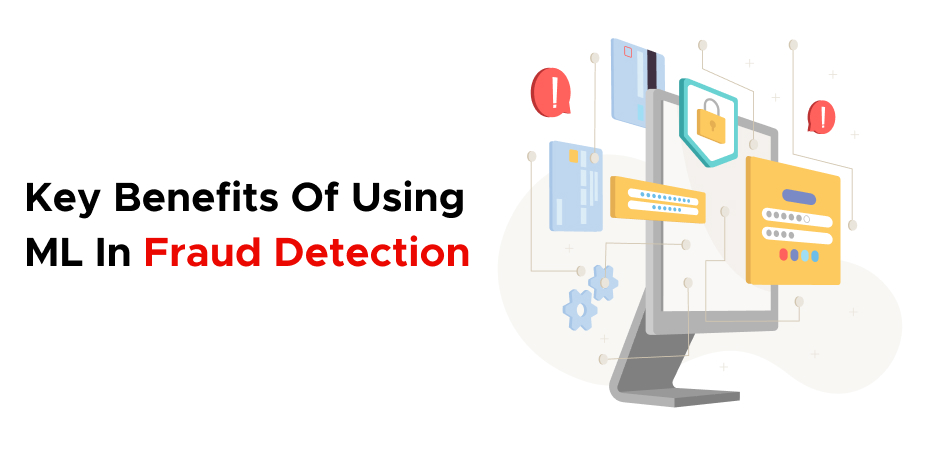4 Apr 2025
7 Essential Machine Learning Techniques for Fraud Detection
Shaun Bell

Fraudsters have an unending game of digital hide-and-seek going on. Now they are playing; machine learning is a dear seeker. Before the advent of modern times, fraud detection used to function exclusively through slugging pace rule-based systems, which no longer suffice. Current fraud detection systems with machine learning possess near superhuman abilities to identify suspicious activities with velocity surpassing “unauthorized transaction” declarations. Machine learning app development serves as a vital mechanism to boost fraud protection technologies.
This is a detective who never sleeps, an analyst continuously analyzing millions of transactions, detecting patterns, and flagging anything suspicious. Whereas traditional methods rely on predefined rules of thumb (“If A happens, then B must be a fraud!”), machine learning says, “Hold my algorithm,” and constantly adapts, learning from new data and outsmarting scammers in real time.
AI vs. Fraudsters: The Silent Battle Protecting Your Bank Account
Are you wondering about a scenario where the card-suspending action after a questionable purchase on the account appears magically at your bank? There goes machine learning for detecting fraud, bumping from behind, identifying strange behavior, and treading in there as quickly as you notice something amiss. And because deep learning and artificial intelligence models are evolving at the speed of light, criminals fight far in between. A UI UX app development company integrates sophisticated fraud detection features into user-friendly applications that maintain an appealing design for seamless implementation by end-users.
Next time you see the popup that says fraud alert, doff your hat to the invisible army of algorithms keeping your money secure. The future is already here–Machine Learning is fighting fraud one dataset at a time! Machine learning application development focuses on creating intelligent systems because they improve performance and decision-making functions.

Machine Learning App Development: What Is Machine Learning & How It Helps in Fraud Detection?
Fraud and fraud prevention techniques are transforming. If cybercriminals sharpen their knives, businesses will require a sharper tool to counter that. Enter machine learning in fraud detection- in speedier, intelligent, self-improving technology that accelerates the sniffing and fraud detection process than orthodox methods. But what precisely is machine learning, and how does it work in fraud detection? Here follows a demystification. Advanced fraud detection systems require machine learning app development services as their integral building component.
What is Machine Learning?
Computers acquire data patterns through machine learning (ML), which operates as a sub-field under artificial intelligence (AI) without requiring programmed instructions. The processing of inputs into outputs through static rules is not how ML models function. They need to review extensive data volumes to detect anomalies while improving their performance over time. Machine learning app development represents a vital element that enhances the detection of frauds.
It is like teaching a super-smart detective. The more cases it sees, the better it becomes at figuring out questionable behavior. From face identification to tailored suggestions through fraud detection, ML will change all these industries and have one of the most life-changing uses. A flutter application development company uses machine learning to build its connected and intelligent security applications which advance industrial operational efficiency across diverse sectors.
How Machine Learning Helps in Fraud Detection
1. Detecting Anomalies Within Transactions
Traditionally, fraud detection systems entailed preset rules, like blocking a transaction if the amount exceeded a certain threshold. However, fraudsters are getting better and have started using techniques that help them fetch around these fixed rules. Machine-learning fraud detection now analyzes thousands, even millions, of transactions in real-time, scanning across subtle deviations that might indicate possible fraud-e.g., unusual locations from which purchases were made or atypical spending patterns.

2. Reducing False Positives
Have you ever had a legitimate purchase flagged as fraud? That’s because these systems are sometimes overly cautious. ML models’ accuracy has increased significantly since they differentiate between actual fraud and harmless anomalies: false alarms are reduced, making customer-friendly experiences. The purpose of machine learning application development is to construct automated systems which maximize performance while making better choices.
3. Real-Time Fraud Prevention
Speed is the essence of fraud detection. ML-powered systems inspect simultaneously occurring transactions to detect unusual patterns, which results in pre-blocking suspected irregular activities. Processing millions of daily transactions requires this security method in banks, e-commerce, and fintech. The main focus of machine learning application development involves constructing intelligence-based systems for enhancing performance and decision outcomes. Machine learning app development services fundamentally contribute to the creation of sophisticated detection systems for identifying fraudulent activities.
4. Learn and Evolve
Although fraud tactics change constantly, ML models will keep changing with time. They will continue learning as they run through new samples of fraud patterns, thus keeping ahead of cyber criminals and making them much more effective than static rule-based systems. Through machine learning techniques a flutter app development company can build intelligent connected applications which boost security operations and operational efficiency in multiple industries.
Despite their frequent usage, interchanged AI and ML represent different concepts even though they share a relationship. Although related, they operate under different functional boundaries. Let’s break it down.
How Do Machine Learning and AI Technology Differ in Machine Learning App Development?
1. What Is Artificial Intelligence (AI)?
Computers featuring human intellect operate as the fundamental focus of the computer science field, AI. Both rule-based automation and deep learning models exist within the field of artificial intelligence. Through AI, machines gain the ability to tackle problems while making decisions and perform natural language understanding.
Under the overall concept of AI, numerous technologies operate together, including machine learning. Siri and autonomous vehicles process information through artificial intelligence while making wise choices. Machine learning app development stands as a fundamental instrument for improving businesses to detect fraud.
2. What Is Machine Learning (ML)?
Machine learning operates as an artificial intelligence sub-subset that permits computer systems to acquire knowledge from data while upgrading their operation autonomously without predetermined coding instructions. ML models detect patterns, predict, and learn from regularly acquired data. A machine learning app development company provides assistance for deploying sophisticated fraud detection solutions.
The analysis of previous activities by recommendation engines on Netflix and banking institutions for fraud detection utilizes ML algorithms to predict forthcoming results. The main objective of machine learning application development deals with creating these intelligent systems to enhance operational performance and decision-making capabilities. Machine learning application development works on construction of these intelligent systems with the purpose of enhancing decision-making and operational performance.

3. Key Differences
1. Scope and Definition
Artificial Intelligence (AI) is an extensive domain that develops multiple technologies to emulate human-level intellect. Machine Learning (ML) is a specialized portion of AI devoted to data-based learning. AI features three elements: rule-based systems, robotics, and expert systems, even though operation does not strictly depend on data learning. When a system uses ML, it requires extensive datasets to train its models to identify patterns and enhance its predictive capabilities during continual learning operations. Machine learning application development uses its techniques to develop intelligent systems for maximizing performance alongside decision-making capabilities.
2. Learning vs. Rule-Based Systems
Although AI operates based on predefined rules, it does not need learning to execute specific tasks. AI-powered chatbots implement predefined scripts to perform question-answering tasks even though they cannot advance their responses during operation. The algorithms in ML systems learn from data, so the systems improve accuracy simultaneously with increased exposure to new information.
3. Applications and Techniques
Artificial intelligence’s three core aspects are robotic systems, natural language processing, and automated reasoning. Machine Learning is a statistical learning approach incorporating three distinct methodologies: used, unsupervised, and reinforcement learning. Every system built under the ML framework belongs to AI, but AI contains types of systems that have never implemented ML technology. The definition separates AI as a master concept that contains ML, which enables data-driven decision-making through its fundamental functions.
4. Dependency on Data
AI systems can run without requiring data-driven learning methods because they make decisions through predefined rules or expert systems. All ML operations depend entirely on existing data for training and performance enhancement. Intelligent models based on ML rely heavily on the quality and the amount of available data since they develop their knowledge by extracting patterns from current data sets. The functionality of AI systems without ML remains intact when using predefined logic, while insufficient data causes ML algorithms to generate unreliable results.
Machine Learning vs. Old-School Fraud Detection
1. Approach to Fraud Detection
The traditional method of fraud detection hinges on rule-based systems that usually rely on signals laid down before time to detect fraud. This system employs if-then rules to flag transactions beyond a certain amount or excessive purchases from multiple locations in a short time. These set rules are inflexible and cannot adapt to ever-changing fraud tactics. Machine learning, however, is a data-driven algorithm, meaning it learns about the frauds perpetrated in the past to identify complex patterns and anomalies in real time. Machine learning in mobile app development enables better fraud detection through adaptive security systems embedded within applications.

2. Adaptability and Accuracy
Old-time detection methods for fraud are relatively static and need manual updates in case of the transformation of new fraud tricks. Otherwise, they end up being sluggish in responding to sophisticated fraud schemes. Contrary to that, an ML technique learns more and more with the introduction of new data; thus, it is adaptive and accurate. A model created through ML can trace very subtle patterns of fraud that rule-based systems can brush aside. And these very patterns reduce false positives and false negatives. Machine learning app development services serve as critical components to construct such sophisticated fraud detection systems.
3. Speed and Efficiency
Classic systems matter greatly for human intervention in examining flagged transactions, which takes time. ML makes the entire process very fast and automated. It can analyze thousands of transactions instantly and detect frauds faster and more efficiently than ever. It streamlines the analysis tasks and increases safety. Machine learning app development stands as a vital factor in improving systems that detect fraud. The goal of machine learning application development involves constructing these intelligent systems which improve decision features and system functions.
4. Handling Large-Scale Data
With online transactions soaring, fraud detection must analyze vast amounts of data. Rule-based systems find little grace in scalability; for every new fraud pattern they add, they complicate their already complex structures and, therefore, require more management. ML has no performance issues detecting fraudulent trends across millions of transactions and is excellent at big-data analysis. A machine learning app development company provides expertise for deploying sophisticated fraud prevention tools.
7 Essential Machine Learning Techniques for Fraud Detection in Machine Learning App Development
With machine learning (ML) being the next frontier in fraud detection, the various facets of fraud detection are being studied and applied in the real world. Traditional rule-based systems are losing their grip with the changing trends of fraudsters. At the same time, the nature of ML techniques allows them to reach out deeply to understand complicated patterns, detect anomalies, and keep improving. Below are seven essential ML techniques in fraud detection.
1. Supervised Learning in Fraud Classifications
Supervised learning is one of the most commonly used ML techniques for fraud detection. It requires a model to be trained with labeled historical data whereby transactions are said to be fraudulent or not fraudulent. Logistic regression random forests predict fraud by analyzing transaction amount, location, and frequency features. Supervised learning models function accurately based on the quality and diversity of training data. Businesses deploy machine learning in mobile app development to establish adaptive fraud detection systems capable of responding to new security challenges.
2. Unsupervised Learning in Anomaly Detection
Unsupervised learning is suited to situations where labeled fraud data tends to be scarce. Instead of adhering to geometric patterns of fraud defined a priori, it detects anomalies based on departures from normal transaction behavior. Clustering techniques (k-means, etc.) and autoencoders are then used to analyze abnormal transaction patterns that require further investigation. This model is advantageous for spotting a new or changing type of fraud that a rule-based system may miss.
3. Semi-Supervised Learning Improving Effectiveness in Machine Learning App Development
Semi-supervised learning merges elements of both supervised and unsupervised learning. It utilizes minor labeled fraud cases and a larger pool of unlabeled transactions to increase fraud detection accuracy. The method works very well when fraud labels are scarce: it allows the model to learn from labeled and unlabeled data, thereby improving the effectiveness of detecting very sophisticated fraud patterns. The development of fraud detection systems for iOS applications becomes possible through the use of this approach by iPhone app development companies.

4. Deep Fraud Analysis with Neural Networks
Deep learning (a subfield of ML), which employs artificial neural networks (ANNs), processes vast amounts of transactional data. Fraud detection, in particular, uses RNNs and long short-term memory (LSTM) networks, which analyze sequential patterns of transactions over time. These models are exceptionally good at recognizing hidden relationships among variables to detect complex fraud patterns that traditional ML models could ignore.
5. Anomaly Detection Using Autoencoders
Neural networks of the autoencoder variety prove highly useful for identifying fraudulent transactions even though they operate without needing pre-encoded information. These systems first reduce transaction data dimensions before restoring the data from the compressed format. The magnitude of the reconstruction error signals potential fraud because high values suggest an abnormality exists. The ability of Autoencoders to detect fraud in real-time applications proves essential for banks and e-commerce operations whose fraud patterns stay under constant evolution.
6. Reinforcement Learning for Adaptive Fraud Prevention
Within reinforcement learning (RL), the model adopts an advanced learning approach via trial and error methods. The system applies updates to its fraud detection tactics by using feedback data from previous decisions. The application of RL proves highly beneficial when controlling fraud patterns in constantly changing environments. The detection strategy of reinforcement learning optimizes itself chronologically to make better fraud detection while minimizing false alarms. The technology allows iPhone app development companies to construct sophisticated fraud detection systems for their iOS applications.
7. Graph-Based Machine Learning for Network Fraud Detection
The framework of interconnected entities makes numerous unlawful operations, such as money laundering and transaction fraud, possible. Using graph analysis, ML techniques detect fraudulent activities by examining network entity relationships. The systems that analyze transactional connections using Graph neural networks (GNNs) and link analysis identify fraud rings, synthetic identity fraud, and collusion networks. The technique finds particular effectiveness during financial criminal investigations.
3 Major Benefits of Machine Learning for Fraud Detection
Machine learning technology introduced new fraud detection possibilities enabled by more precise results at lower costs and dynamic frameworks that overcame previously used rule-based systems. Businesses can detect sophisticated fraud techniques with the help of ML because it produces pattern analysis and anomaly detection while developing its detection capability over time. The employment of ML for fraud detection provides three primary advantages. Evaluation of fraud detection needs machine learning app development because it enables improved capabilities.
1. Improved Accuracy and Reduced False Positives in Machine Learning App Development
The standard operational systems for detecting fraud cause numerous illegal access exception mistakes by wrongly classifying approved deals as fraudulent actions. The exactitude of ML applications rises through data analysis, which enables it to detect sophisticated patterns in fraud activity. ML employs decision trees, neural networks, and anomaly detection models to minimize false positives through accurate identification of actual cases of fraud. The system provides customers with improved security standards throughout their experience. A UI/UX app development company integrates advanced fraud detection elements into user-friendly visually pleasing applications.
2. Real-Time Fraud Detection and Prevention
ML-based fraud detection tools evaluate current transactions to provide businesses with instant detection and prevention of fraudulent attempts. Enterprises using ML models bypass time-consuming manual assessment methods through which rapid dataset processing detects fraudulent practices in real time. Quick detection reduces financial losses and stops fraudulent activities before seriously damaging business operations.

3. Adaptability to Evolving Fraud Tactics
Most fraud methods dynamically evolve to an extent that makes standard rule-based security tools obsolete. ML systems learn new fraud behavior, continuously improving their ability to detect suspicious activities. Through reinforcement learning and anomaly detection methods, businesses can stay ahead of changing security threats using proactive fraud prevention approaches. The implementation of advanced fraud detection solutions requires support from a machine learning app development company.
How Does Machine Learning-Based Fraud Detection Operate?
An intelligent way of fraud detection with machine learning (ML) is another wing of machine learning that helps businesses detect fraud and fraudsters better than rule-based methods. The ML algorithms analyze large datasets, keep track of anomalies, and learn from changing fraud patterns. The main goal of machine learning application development is to establish intelligent systems which enhance performance along with decision-making capabilities.
1. Data Collection and Preprocessing
The initial step in ML-based fraud detection is gathering relevant data such as transaction, user behavior, location, and device data. Once collected, cleaning and preprocessing the data remove inconsistencies, treat missing data, and normalize features. Accurate data representation is of utmost importance in training fraud detection models. A machine learning app development company develops and implements sophisticated fraud prevention solutions.
2. Feature Engineering and Selection
Feature engineering involves defining the indicators of fraudulent behavior, e.g., transaction frequency, purchase history, and even strange IP addresses. Choosing only those most relevant features enhances model performance by directing attention to the most significant patterns for fraud detection.

3. Model Training and Learning
ML models are trained on historical data with fraudulent and legitimate transactions and classify this information in supervised learning using decision trees, neural networks, and logistic regression. The algorithms label the transactions as fraud or non-fraud based on the information. Using unsupervised algorithms, such as anomaly detection or clustering, irregularities in the data can also signal suspicious transactions without the need for labeled fraud data.
4. Real-Time Fraud Detection and Decision Making in Machine Learning App Development
Once trained, the ML model is put into production and employed to monitor real-time transactions. The model scores transactions with a fraud probability score depending on the patterns learned during training. Transactions flagged as high-risk undergo further investigation, whereas transactions deemed legitimate flow smoothly through the process. Through collaboration with an Android app development company these machine learning models become part of mobile applications which increases security protocols and detects fraudulent activities.
5. Continuous Learning and Improvement
Fraud patterns constantly change, so the ML model should be enrolled into an update and retraining process with new data. This leads to continual improvement of fraud detection accuracy with adaptive techniques like reinforcement learning. The advent of machine learning in mobile app development enables businesses to develop fraud detection systems which adapt autonomously to emerging security risks.
Conclusion
Adopting machine learning improves fraud identification through quicker detection at higher precision standards compared to standard scheme evaluation algorithms. Advanced techniques have become crucial for businesses to detect and prevent sophisticated fraud tactics effectively. Advanced fraud detection solutions require implementation from a machine learning app development company.
Through supervised learning, fraud detection processes identify past data patterns, but unsupervised learning reveals abnormal activities that signify unknown fraud patterns. Semi-supervised learning techniques capitalize on labeled and unlabeled data to enhance accuracy, especially when restricted fraud data is available. The implementation of machine learning models by an Android app development company leads to mobile application capabilities that improve security alongside fraud detection abilities.
Machine learning helps businesses decrease fraud-related costs and maximize customer security and process efficiency. The ability of machine learning to detect fraud in real time allows for fewer false alarms, and it enhances its capabilities through continuous feedback from new incoming data. The fight against sophisticated fraud requires business organizations to rely on evolving machine learning models to maintain their defense. Organizations that fund ML-based fraud identification systems boost their ability to safeguard monetary resources through strong digital protection measures.








